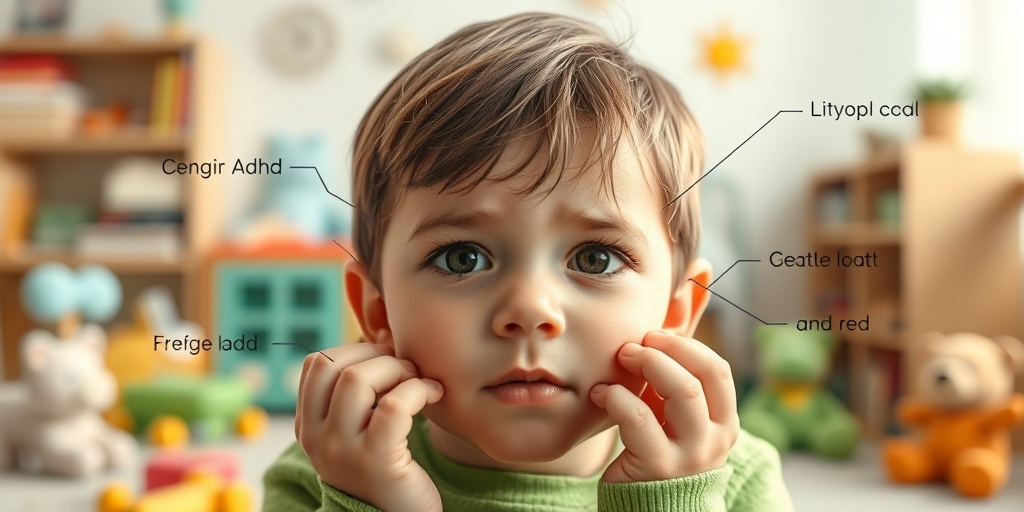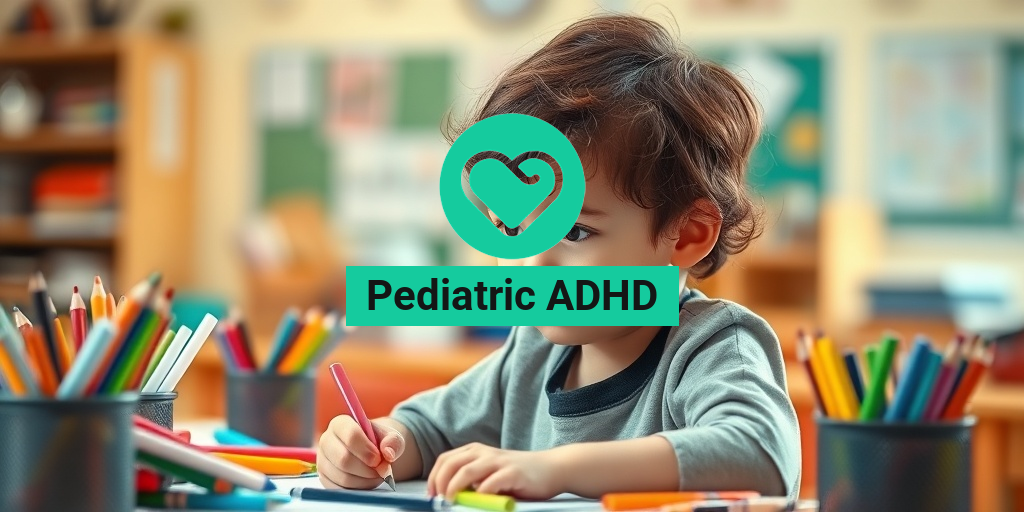What Is Pediatric ADHD?
Pediatric ADHD, or Attention Deficit Hyperactivity Disorder, is a neurodevelopmental disorder that affects children and adolescents. It is characterized by persistent patterns of inattention, hyperactivity, and impulsivity that can interfere with daily functioning and development. Understanding this condition is crucial for parents, educators, and healthcare providers to ensure that affected children receive the support they need.
ADHD is not just a childhood disorder; it can continue into adolescence and adulthood. However, when we refer to Pediatric ADHD, we focus specifically on its manifestation in younger populations. The exact cause of ADHD is still not fully understood, but research suggests that genetics, brain structure, and environmental factors may play significant roles.
Types of Pediatric ADHD
Pediatric ADHD is generally categorized into three types, based on the predominant symptoms:
- Predominantly Inattentive Presentation: Children may struggle to focus, follow instructions, and complete tasks.
- Predominantly Hyperactive-Impulsive Presentation: This type is characterized by excessive movement, fidgeting, and impulsive actions.
- Combined Presentation: A mix of both inattentive and hyperactive-impulsive symptoms.
Recognizing the type of ADHD a child has is essential for effective treatment and management strategies. If you suspect your child may have ADHD, seeking a pediatric ADHD evaluation from a qualified specialist is a crucial first step.
Pediatric ADHD Symptoms
Identifying the symptoms of Pediatric ADHD can be challenging, as they often overlap with typical childhood behaviors. However, there are specific signs to look for that may indicate a child is struggling with this disorder.
Common Symptoms of Inattention
Children with the inattentive type of ADHD may exhibit the following symptoms:
- Difficulty sustaining attention: They may find it hard to focus on tasks or play activities.
- Frequent careless mistakes: This can occur in schoolwork or other activities.
- Difficulty organizing tasks: They may struggle to keep track of assignments or belongings.
- Avoidance of tasks requiring sustained mental effort: Homework or chores may be particularly challenging.
Common Symptoms of Hyperactivity and Impulsivity
For children exhibiting hyperactive and impulsive behaviors, symptoms may include:
- Fidgeting or tapping hands or feet: They may seem restless and unable to stay still.
- Talking excessively: This can lead to interrupting others or dominating conversations.
- Difficulty waiting for their turn: They may struggle in group settings or during games.
- Acting without thinking: This impulsivity can lead to risky behaviors.
When to Seek Help
If you notice these symptoms persisting over time and affecting your child’s daily life, it may be time to consult a pediatric ADHD specialist near you. Early intervention can make a significant difference in managing symptoms and improving your child’s quality of life.
Additionally, various pediatric ADHD assessment tools are available to help healthcare providers evaluate and diagnose the condition accurately. These tools often include questionnaires, behavioral checklists, and interviews with parents and teachers.
Conclusion
Pediatric ADHD is a complex disorder that requires understanding and support from parents, educators, and healthcare professionals. By recognizing the symptoms and seeking appropriate evaluations, you can help your child navigate the challenges associated with ADHD. For more information and resources, consider visiting Yesil Health AI, where you can find evidence-based health answers tailored to your needs.
Remember, you are not alone in this journey. With the right support and resources, children with Pediatric ADHD can thrive and reach their full potential! 🌟

Causes of Pediatric ADHD
Attention-Deficit/Hyperactivity Disorder (ADHD) is a complex neurodevelopmental disorder that affects children and can continue into adulthood. Understanding the causes of Pediatric ADHD is crucial for parents, educators, and healthcare professionals. While the exact cause remains unclear, several factors contribute to the development of this condition.
Genetic Factors
Research indicates that genetics play a significant role in the development of Pediatric ADHD. Children with a family history of ADHD are more likely to be diagnosed with the disorder themselves. Studies suggest that multiple genes may be involved, influencing neurotransmitter systems in the brain, particularly those related to dopamine, which is crucial for attention and impulse control.
Environmental Influences
Environmental factors can also contribute to the onset of Pediatric ADHD. Some of these include:
- Exposure to Toxins: Prenatal exposure to substances like tobacco smoke, alcohol, and drugs can increase the risk of ADHD. Additionally, exposure to environmental toxins such as lead may also play a role.
- Low Birth Weight: Children born with low birth weight or those who experience premature birth are at a higher risk of developing ADHD.
- Brain Injuries: Traumatic brain injuries during early childhood can affect brain development and lead to symptoms associated with ADHD.
Neurological Factors
Studies have shown that children with ADHD often exhibit differences in brain structure and function. Areas of the brain responsible for attention, impulse control, and executive function may develop differently in children with ADHD. These neurological differences can manifest as challenges in focusing, organizing tasks, and regulating behavior.
Psychosocial Factors
While genetics and biology are significant, psychosocial factors can also influence the severity and manifestation of ADHD symptoms. Factors such as:
- Family Dynamics: A chaotic home environment or inconsistent parenting can exacerbate symptoms of ADHD.
- Socioeconomic Status: Children from lower socioeconomic backgrounds may face additional stressors that can impact their behavior and attention.
- Peer Relationships: Difficulties in social interactions can lead to increased frustration and behavioral issues in children with ADHD.
Risk Factors for Pediatric ADHD
Identifying the risk factors for Pediatric ADHD can help in early detection and intervention, which is crucial for effective management of the disorder. Here are some key risk factors to consider:
Family History
As mentioned earlier, a family history of ADHD significantly increases the likelihood of a child being diagnosed with the disorder. If a parent or sibling has ADHD, the child is at a higher risk, indicating a strong genetic component.
Gender
ADHD is more commonly diagnosed in boys than in girls. While boys often exhibit more hyperactive and impulsive behaviors, girls may present with inattentiveness, which can sometimes lead to underdiagnosis. Understanding this gender difference is essential for accurate assessment and treatment.
Age of Diagnosis
Children diagnosed with ADHD at a younger age may experience more severe symptoms. Early diagnosis can lead to timely interventions, which can help mitigate the impact of the disorder on a child’s development.
Coexisting Conditions
Children with ADHD often have coexisting conditions such as anxiety disorders, depression, or learning disabilities. These comorbidities can complicate the diagnosis and treatment of ADHD, making it essential for healthcare providers to conduct comprehensive evaluations.
Environmental Stressors
Children exposed to high levels of stress, whether from family issues, school challenges, or community violence, may be at an increased risk for developing ADHD. Creating a supportive and stable environment can help reduce these risks.
In conclusion, understanding the causes and risk factors associated with Pediatric ADHD is vital for parents and caregivers. By recognizing these elements, families can seek appropriate evaluations and interventions, ensuring that children receive the support they need to thrive. 🌟
![]()
Diagnosing Pediatric ADHD
Diagnosing Pediatric ADHD (Attention-Deficit/Hyperactivity Disorder) can be a complex process that requires careful evaluation by healthcare professionals. Understanding the signs and symptoms is crucial for parents and caregivers who suspect their child may be affected by this condition.
Understanding the Symptoms
The symptoms of Pediatric ADHD typically fall into two categories: inattention and hyperactivity-impulsivity. Here are some common signs to look out for:
- Inattention: Difficulty sustaining attention in tasks, frequent careless mistakes, and trouble organizing activities.
- Hyperactivity: Fidgeting, difficulty remaining seated, and excessive talking.
- Impulsivity: Interrupting others, difficulty waiting for their turn, and making hasty decisions without considering consequences.
The Evaluation Process
If you suspect your child may have ADHD, the first step is to consult a Pediatric ADHD specialist. The evaluation process typically includes:
- Clinical Interview: A detailed discussion about your child’s behavior, development, and family history.
- Behavioral Assessments: Standardized questionnaires and rating scales filled out by parents and teachers to assess behavior in different settings.
- Medical Examination: A physical exam to rule out other conditions that may mimic ADHD symptoms.
It’s important to note that there is no single test for ADHD. Instead, the diagnosis is made based on a comprehensive assessment of the child’s behavior and functioning across various environments, such as home and school.
Where to Get Help
Finding a Pediatric ADHD evaluation near me can be as simple as searching online or asking your pediatrician for recommendations. Many healthcare providers specialize in ADHD assessments and can guide you through the process.
Treatment Options for Pediatric ADHD
Once a diagnosis of Pediatric ADHD is confirmed, parents often wonder about the best treatment options available. Treatment plans are typically tailored to the individual child’s needs and may include a combination of behavioral therapies, educational support, and medication.
Behavioral Therapy
Behavioral therapy is often the first line of treatment for children with ADHD. This approach focuses on modifying specific behaviors through reinforcement strategies. Some effective techniques include:
- Parent Training: Teaching parents strategies to manage their child’s behavior effectively.
- Behavioral Interventions: Implementing reward systems to encourage positive behavior.
- Social Skills Training: Helping children develop better interpersonal skills.
Educational Support
Children with ADHD often benefit from tailored educational support. This may involve:
- Individualized Education Programs (IEPs): Customized learning plans that address specific needs.
- Classroom Accommodations: Modifications such as extended time on tests or a quieter workspace.
Medication Options
In some cases, medication may be recommended to help manage symptoms of Pediatric ADHD. Commonly prescribed medications include:
- Stimulants: Such as methylphenidate and amphetamines, which are often effective in reducing symptoms.
- Non-Stimulants: Such as atomoxetine, which may be prescribed if stimulants are not suitable.
It’s essential to work closely with a healthcare provider to monitor the child’s response to medication and make adjustments as needed. Regular follow-ups can help ensure the treatment plan remains effective.
Finding the Right Pediatric ADHD Doctor
When searching for a Pediatric ADHD doctor near me, consider looking for specialists with experience in diagnosing and treating ADHD. Recommendations from other parents, online reviews, and consultations can help you find the right fit for your child.
In conclusion, diagnosing and treating Pediatric ADHD involves a comprehensive approach that includes understanding symptoms, thorough evaluations, and tailored treatment plans. With the right support, children with ADHD can thrive and reach their full potential! 🌟

Managing Pediatric ADHD at Home
Managing Pediatric ADHD at home can be a challenging yet rewarding experience for families. Understanding the condition and implementing effective strategies can significantly improve the quality of life for both children and their parents. Here are some practical tips to help you navigate this journey.
Establish a Routine
Children with ADHD often thrive in structured environments. Establishing a consistent daily routine can help them feel more secure and focused. Here are some steps to create an effective routine:
- Morning Rituals: Start the day with a predictable morning routine that includes time for breakfast, hygiene, and preparation for school.
- Homework Schedule: Designate specific times for homework and study sessions, minimizing distractions during these periods.
- Evening Wind Down: Create a calming evening routine that helps your child transition to bedtime, such as reading or quiet activities.
Utilize Visual Aids
Visual aids can be incredibly helpful for children with ADHD. Consider using:
- Charts and Checklists: Create visual schedules or checklists for daily tasks to help your child stay organized.
- Color-Coded Systems: Use colors to differentiate between subjects or activities, making it easier for your child to focus on one task at a time.
Encourage Physical Activity
Regular physical activity is essential for children with ADHD. It helps to burn off excess energy and improve concentration. Aim for at least 30 minutes of exercise each day, which can include:
- Outdoor Play: Encourage activities like biking, running, or playing sports.
- Structured Classes: Consider enrolling your child in dance, martial arts, or swimming classes to provide a fun outlet for their energy.
Implement Positive Reinforcement
Positive reinforcement can motivate children with ADHD to engage in desired behaviors. Here are some effective strategies:
- Reward Systems: Create a reward chart where your child can earn points or stickers for completing tasks or exhibiting good behavior.
- Verbal Praise: Regularly acknowledge and praise your child’s efforts, no matter how small, to boost their self-esteem.
Support for Families of Children with ADHD
Supporting a child with Pediatric ADHD can be overwhelming, and it’s essential for families to seek help and resources. Here are some ways to find support:
Connect with Support Groups
Joining a support group can provide families with a sense of community and understanding. Look for local or online groups where you can share experiences, challenges, and solutions with other parents facing similar situations. These connections can be invaluable for emotional support and practical advice.
Consult with Professionals
Don’t hesitate to reach out to professionals who specialize in Pediatric ADHD. This may include:
- Pediatric ADHD Specialists: These professionals can provide tailored advice and treatment options for your child.
- Therapists: Behavioral therapy can be beneficial for both children and parents, helping to develop coping strategies and improve communication.
Educate Yourself and Your Family
Understanding ADHD is crucial for everyone in the family. Consider the following:
- Read Books: Look for books specifically about ADHD that can provide insights and strategies.
- Attend Workshops: Many organizations offer workshops and seminars on managing ADHD, which can be a great resource for families.
Practice Self-Care
As a caregiver, it’s essential to prioritize your own well-being. Caring for a child with ADHD can be demanding, so make sure to:
- Take Breaks: Schedule regular time for yourself to recharge, whether it’s through hobbies, exercise, or relaxation.
- Seek Counseling: If you’re feeling overwhelmed, consider talking to a counselor or therapist who can help you navigate your feelings and stress.
By implementing these strategies and seeking support, families can create a nurturing environment that fosters growth and understanding for children with Pediatric ADHD. Remember, you are not alone on this journey! 🌟

Frequently Asked Questions about Pediatric ADHD
What is Pediatric ADHD?
Pediatric ADHD refers to Attention Deficit Hyperactivity Disorder diagnosed in children and adolescents. It is characterized by symptoms such as inattention, hyperactivity, and impulsivity, which can affect a child’s daily functioning and development.
How is Pediatric ADHD diagnosed?
The diagnosis of Pediatric ADHD typically involves a comprehensive evaluation by a healthcare professional. This may include:
- Clinical interviews with parents and teachers
- Behavioral assessments
- Standardized rating scales
- Observation of the child’s behavior
What are the common symptoms of Pediatric ADHD?
Common symptoms of Pediatric ADHD include:
- Difficulty sustaining attention
- Frequent fidgeting or restlessness
- Impulsive decision-making
- Difficulty following instructions
- Challenges in organizing tasks
What are the treatment options for Pediatric ADHD?
Treatment for Pediatric ADHD may include:
- Behavioral therapy
- Medication, such as stimulants or non-stimulants
- Parent training and support
- School accommodations
How can I find a Pediatric ADHD specialist near me?
To find a Pediatric ADHD specialist near you, consider:
- Asking your pediatrician for recommendations
- Searching online directories of mental health professionals
- Contacting local hospitals or clinics that specialize in child psychology
What is involved in a Pediatric ADHD evaluation?
A Pediatric ADHD evaluation typically includes a detailed history of the child’s behavior, input from parents and teachers, and standardized tests to assess attention and behavior. This comprehensive approach helps ensure an accurate diagnosis.
Are there specific assessment tools for Pediatric ADHD?
Yes, there are several Pediatric ADHD assessment tools that professionals may use, including:
- Conners 3rd Edition (Conners 3)
- Behavior Assessment System for Children (BASC)
- Vanderbilt ADHD Diagnostic Rating Scale
What medications are commonly prescribed for Pediatric ADHD?
Common medications for Pediatric ADHD include:
- Stimulants (e.g., methylphenidate, amphetamines)
- Non-stimulants (e.g., atomoxetine, guanfacine)
It’s important to work closely with a healthcare provider to determine the best medication and dosage for your child.
How can I support my child with Pediatric ADHD?
Supporting a child with Pediatric ADHD involves:
- Establishing a consistent routine
- Using positive reinforcement
- Encouraging open communication
- Collaborating with teachers and school staff
Where can I get Pediatric ADHD testing near me?
To find Pediatric ADHD testing services near you, consider:
- Contacting local mental health clinics
- Inquiring at your child’s school for resources
- Searching online for child psychologists or psychiatrists
What should I do if I suspect my child has Pediatric ADHD?
If you suspect your child may have Pediatric ADHD, it is important to consult with a healthcare professional. Early intervention can significantly improve outcomes for children with ADHD.




